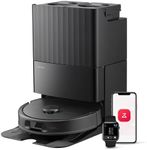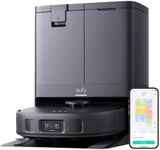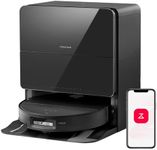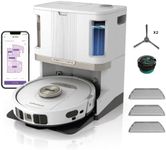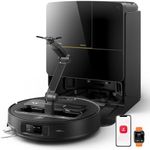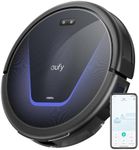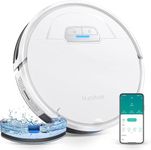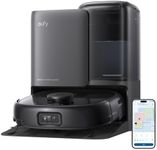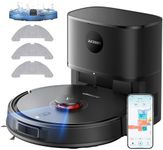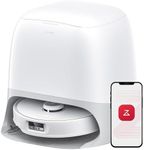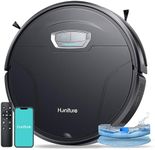Buying Guide for the Best Robot Vacuum For Pets
Choosing the right robot vacuum for homes with pets can make a significant difference in maintaining cleanliness and managing pet hair. Pet owners need to consider several key specifications to ensure the vacuum can handle the unique challenges posed by pet hair, dander, and occasional messes. Understanding these specifications will help you select a model that fits your specific needs and keeps your home clean and comfortable for both you and your pets.Suction PowerSuction power determines how effectively the vacuum can pick up dirt, debris, and pet hair from various surfaces. Higher suction power is crucial for homes with pets, as it ensures that even the most stubborn pet hair is removed from carpets and hard floors. Suction power is usually measured in Pascals (Pa). For homes with pets, look for a vacuum with at least 2000 Pa. If you have multiple pets or pets that shed heavily, consider models with even higher suction power to ensure thorough cleaning.
Brush TypeThe type of brush used by the robot vacuum can significantly impact its ability to pick up pet hair. There are generally two types of brushes: bristle brushes and rubber brushes. Bristle brushes can be effective but may get tangled with pet hair, requiring frequent cleaning. Rubber brushes are better for pet hair as they are less likely to tangle and are easier to clean. If you have pets that shed a lot, a vacuum with rubber brushes is a better choice to minimize maintenance and ensure efficient cleaning.
Filtration SystemA good filtration system is essential for capturing pet dander and allergens, which can improve air quality in your home. High-Efficiency Particulate Air (HEPA) filters are the gold standard, as they can trap tiny particles that other filters might miss. If you or anyone in your household has allergies or asthma, a robot vacuum with a HEPA filter is highly recommended. For general pet owners, a vacuum with a good quality filter will still help reduce allergens and keep the air cleaner.
Battery LifeBattery life determines how long the robot vacuum can clean before needing to recharge. Longer battery life is particularly important for larger homes or homes with multiple pets, as it allows the vacuum to cover more area in a single cleaning session. Battery life is usually measured in minutes, with most models offering between 60 to 120 minutes of runtime. For larger homes or homes with extensive pet hair, look for a vacuum with at least 90 minutes of battery life to ensure it can complete its cleaning cycle without interruption.
Navigation and MappingAdvanced navigation and mapping capabilities help the robot vacuum efficiently clean your home by avoiding obstacles and covering all areas. Features like laser navigation, camera-based mapping, and smart sensors allow the vacuum to create a map of your home and plan the most efficient cleaning route. For homes with pets, this is particularly useful as it ensures the vacuum can navigate around pet beds, toys, and other obstacles. If you have a complex home layout or multiple rooms, a vacuum with advanced navigation and mapping will provide more thorough and efficient cleaning.
Dustbin CapacityThe dustbin capacity determines how much dirt and pet hair the vacuum can hold before needing to be emptied. Larger dustbins are more convenient for homes with pets, as they reduce the frequency of emptying. Dustbin capacity is usually measured in liters, with most models offering between 0.3 to 0.6 liters. For homes with one or two pets, a dustbin capacity of around 0.5 liters should be sufficient. If you have multiple pets or pets that shed heavily, consider a model with a larger dustbin to minimize the need for frequent emptying.
Noise LevelThe noise level of the robot vacuum can affect both you and your pets. Quieter models are less likely to disturb pets and can be run at any time without causing a nuisance. Noise level is usually measured in decibels (dB), with most models ranging from 55 to 70 dB. For a pet-friendly home, look for a vacuum with a noise level of 60 dB or lower to ensure it operates quietly and doesn't stress your pets.

